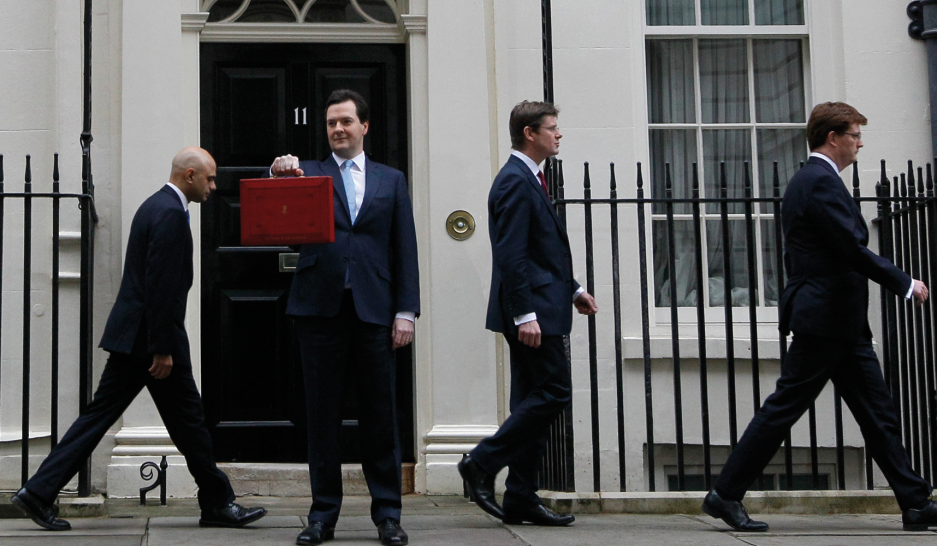Economists have pencilled in few changes this time around, expecting Osborne will allow the economy to continue on its current path.
Speaking to the BBC’s Andrew Marr on Sunday, Osborne said the country’s economic plan is working, but with the usual caveat that the recovery is not secured.
As such, a major shift in strategy is very unlikely. Instead, the Chancellor – with one eye on next year’s election – may throw in a sweetener to cash-strapped families, without doing anything to threaten the recovery.
Below are ten predictions for this year’s Budget:
1) Increase in personal allowance from £10,000 to £10,500
This was mentioned in the Autumn Statement and would kick in from next April, just before the General Election.
An idea first created by the Liberal Democrats, the Tories are attempting to take ownership of it, but the interesting thing to watch out for is whether it goes up by even more. There has been talk of an increase to £10,750.
2) Lifetime allowance to fall from £1.5m to £1.25m
This was announced in the Autumn Statement, but some experts fear it may well be cut further tomorrow.
Anyone who has a pension pot worth more than £.125m after 5 April this year will face a charge of 55%.
3) Reduction in the lump sum you can take as tax free cash
There has also been talk of the government restricting the 25% (£312,500) of your lifetime allowance you can currently take as a tax-free cash lump sum.
This measure may come in with the cut to the overall lifetime allowance, or instead of it.
4) Increase in 40% income tax threshold
The Institute for Fiscal Studies (IFS) says, compared with the state of play when the coalition government took office four years ago, the higher rate threshold has dropped by £4,910, creating an extra 1.1 million higher rate taxpayers.
There are now 4.4 million higher rate taxpayers, and a further 313,000 who pay the 45% additional tax rate on top.
Tory grandees have been pushing for the rate to rise from its current level of £41,450, arguing it was never intended to catch so many people out. However, despite growing pressure on the Chancellor, he may stick to his guns on this and leave it untouched.
5) Inheritance tax
Inheritance tax, a tax that generates greater anger among voters than most others, could also change in this Budget.
There are calls for a review of the inheritance tax nil-rate band of £325,000, at which families become liable to a 40% tax bill.
The IHT threshold is due to stay at its current level until 5 April 2018 but, in light of rising property prices and an election in 2015, the Chancellor could choose to change this.
After all, the tax does not bring in a lot revenue and it is a way to win votes – especially given the Tories’ pre-election promise to increase the IHT threshold to £1m.
6) GDP
In the Autumn Statement, the OBR sharply raised its growth estimate for 2013 from 0.6% to 1.4%.
It also lifted the projection for 2014 markedly from 1.8% to 2.4%. Significantly though, the OBR resisted the temptation to lift the growth projections for 2015-17. In fact, it slightly trimmed the growth forecasts for each year, with 2015 cut to 2.2%, 2016 to 2.6% and 2017 to 2.7%.
The consensus forecast is currently for GDP growth of 2.7% in 2014 – well ahead of the OBR’s own forecast, and 2.4% in 2015. Economists at IHS Global Insight expect growth to be 2.7% in 2014 and 2.6% in 2015, and tomorrow’s Budget could therefore see more upgrades to official forecasts.
7) Public borrowing
In December, the OBR forecast the underlying Public Sector Net Borrowing Requirement (which excludes the impact of the transfer of the Royal Mail Pension Plan’s assets and the transfer of cash from the Bank of England’s Asset Purchase Facility to the Treasury) to fall from £115bn in 2012/13 to £111.1bn in 2013/14, then £96bn in 2014/15 and £23.4bn by 2017/18.
A major development was that a small surplus of £2.2bn is projected in 2018/19.
In March 2013, the OBR had forecast the underlying PSNBR to come in at £119.8bn in 2013/14, falling to £108.4bn in 2014/15 and £42.7bn in 2017/18. As a result, net borrowing in December 2013 was seen £73bn lower between 2013/14 and 2017/18 than it had been in March 2013.
These figures could yet see some more movement tomorrow given the stronger than expected growth seen in the last 12 months.
8) Stamp duty
Stamp duty tax remains a contentious issue for those buying or selling property.
With house prices on the rise, stamp duty is a further obstacle for first time buyers and many believe the market needs a fairer system, which will be both easier and cheaper to administer.
There are calls for a tiered system – for example, 1% tax is paid on the value between £125,000 and £250,000, and 3% on the value between £250,001 and £500,000, in much the same way as income tax works.
9) VCTs/EISs
Investment limits in VCTs and EISs could also be lifted, but restrictions on what can be placed in them may be tightened.
Brewin Dolphin’s Richard Harwood, divisional director of financial planning, said: “Increasingly, EISs and VCTs are providing funding for businesses that would traditionally be the domain of banks.
“But we would not be surprised if there was further tweaking of the rules on what investments are approved in order to ensure there is true risk within the plans and that they are not just schemes to maximise tax reliefs.”
10) Increase to the ISA limit
More of a wish than a certainty in this year’s Budget, there are calls for the ISA limit to be raised substantially. Currently set at £11,520, it rises annually with inflation, so should increase to around £11,750 this year. However, there have also been calls for a much larger increase.















